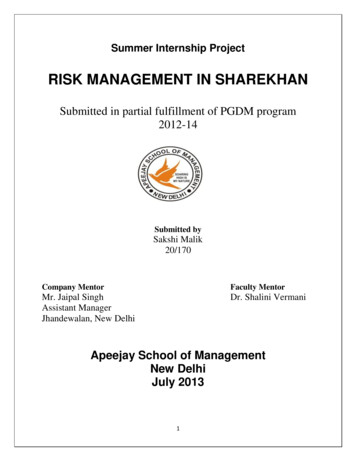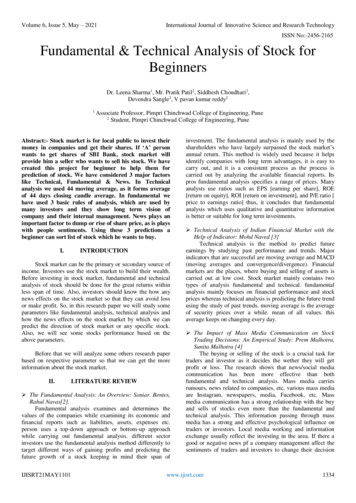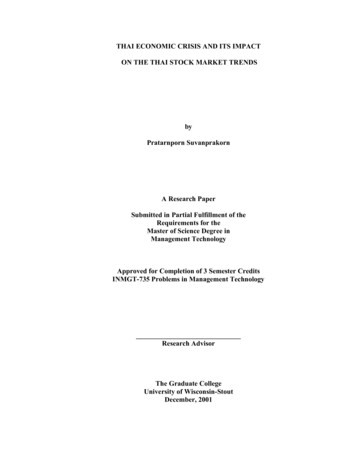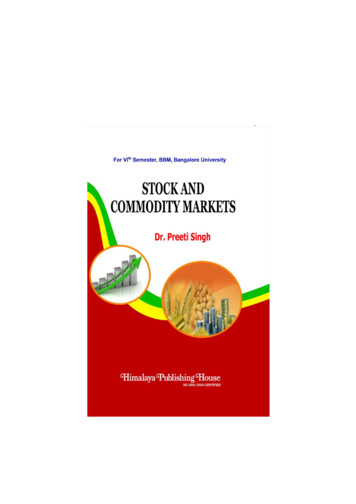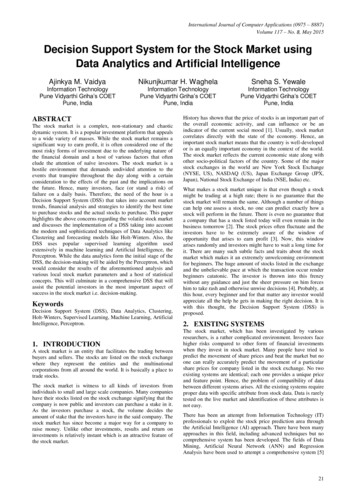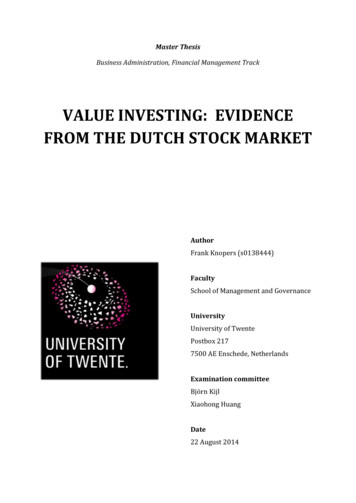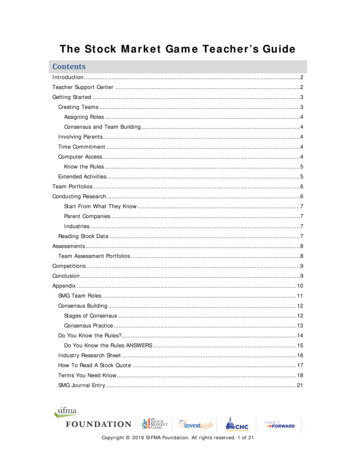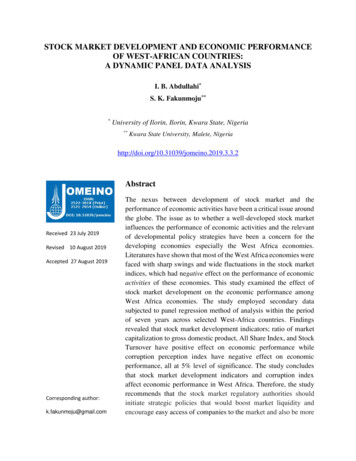
Transcription
STOCK MARKET DEVELOPMENT AND ECONOMIC PERFORMANCEOF WEST-AFRICAN COUNTRIES:A DYNAMIC PANEL DATA ANALYSISI. B. Abdullahi*S. K. Fakunmoju***University of Ilorin, Ilorin, Kwara State, Nigeria**Kwara State University, Malete, bstractReceived 23 July 2019Revised 10 August 2019Accepted 27 August 2019Corresponding author:k.fakunmoju@gmail.comThe nexus between development of stock market and theperformance of economic activities have been a critical issue aroundthe globe. The issue as to whether a well-developed stock marketinfluences the performance of economic activities and the relevantof developmental policy strategies have been a concern for thedeveloping economies especially the West Africa economies.Literatures have shown that most of the West Africa economies werefaced with sharp swings and wide fluctuations in the stock marketindices, which had negative effect on the performance of economicactivities of these economies. This study examined the effect ofstock market development on the economic performance amongWest Africa economies. The study employed secondary datasubjected to panel regression method of analysis within the periodof seven years across selected West-Africa countries. Findingsrevealed that stock market development indicators; ratio of marketcapitalization to gross domestic product, All Share Index, and StockTurnover have positive effect on economic performance whilecorruption perception index have negative effect on economicperformance, all at 5% level of significance. The study concludesthat stock market development indicators and corruption indexaffect economic performance in West Africa. Therefore, the studyrecommends that the stock market regulatory authorities shouldinitiate strategic policies that would boost market liquidity andencourage easy access of companies to the market and also be more
Abdullahi I. B., Fakunmoju S. K.Journal of Management, Economics, and Industrial Organization, Vol.3 No.3, 2019, pp.12-26.proactive in surveillance role in order to check unethical practices which undermine stock marketintegrity, erode investors’ confidence and patronage.JEL Code: G1, O4, C1.Keywords: All share index, Corruption perception index, Market capitalization, Gross domesticproduct, Stock turnover.IntroductionThe role of a high frequent trading and well-functioning stock market is critical to the performanceof economic activities as established in the literature. Generally, sound and developed stock marketenable economic growth through conscription of domestic and foreign financial resources thatfacilitate investment and economic activities, through access to low cost capital by quotedcompanies.The expected benefits of sound stock market have steered the interest of developing economiesaround the globe on appropriate strategies of stock market framework and policies that are suitablein achieving a well-developed stock markets. However, majority of stock markets in thedeveloping economies are yet to achieved the desired aspirations of the developed stock marketdue to the some existing challenges; such as weak corporate governance, regulatory and legalinstitutions, political risk, unethical practices in the stock market especially in the developingeconomies of Africa and as well as the effect of global financial crisis (Hearn & Piesse, 2010;Kemboi & Tarus, 2012; Asongu & Nwachukwu, 2016; Popoola, Ejemeyovwi, Alege & Adu &Onabote, 2017; Igbinosa & Uhunmwangho, 2019).Furthermore, as observed in literature, stock market development has been part of fundamentalfactor to the economic performance. Kuada (2016) and Yartey and Adjasi (2007) are of the opinionthat with financial liberalization and performance of the macroeconomic activities in Africa arenot efficient without the establishment and a well-developed stock markets. The studies of Bhoyu(2011), Khumalo (2013), Cyrus and Kirwa (2015), Mbah, Okoli and Amassoma (2017), Worluand Omodero (2017) among others collaborated that for the developing economies, especially theAfrican economy to achieve stock market development, stock market must be efficient, good inethical practices, continuous increase in market capitalization, high stock turnover and also thefundamental macroeconomic policies; such as the interest rate, Gross Domestic Product (GDP),exchange rate, inflation rate and money supply must be stable.13
Abdullahi I. B., Fakunmoju S. K.Journal of Management, Economics, and Industrial Organization, Vol.3 No.3, 2019, pp.12-26.These problems are further magnified in developing countries especially West Africaneconomies with weak stock markets regulatory framework and high macroeconomic volatilities,informational and disclosure deficiencies reduces the efficiency and stock market developmentwhich in turn lessen local and foreign investors’ confidence and patronage in the stock exchangemarkets (Nkechukwu, Onyeagba & Okoh, 2013; Barakat, Elgazzar & Hanafy, 2016; Kahuthu,2017). The fair growth in the West Africa stock markets do not implies that even the mostseemingly advanced African stock markets are not matured as compared with stock markets indeveloped economies. Most of these stock markets still suffer the problems of low liquidity, highercost of trading, unstable exchange and inflation rates, declined in growth domestic product, lowfrequency trading, information and disclosure deficiencies, poor supervision and regulatoryframework and political instability (Okoye, Modebe, Taiwo & Okorie, 2016; Popoola et al., 2017;African Capital Market News, 2018). Furthermore, studies have shown that countries with lowlevel of corruption practices and well-functioning, sound and developed stock market experienceddrop in poverty levels, increased in foreign investment inflow and well-functioning economicactivities grow more rapidly than those countries with high level of corruption and weak economicindices (Andrianaivo & Yartey, 2009; Beck, Maimbo, Faye & Triki, 2011; Oshaibat, 2016; Wang,Tsai & Li, 2017).Several studies outside Africa countries that investigated the empirical link between stock marketdevelopment and economic growth in different economies, which include Kamaiah and Biswal(2000), Biswal and Veerashekharappa (2002), Adjasi and Biekpe (2006), Agrawala and Tuteja(2007), Brasoveanu, Dragota, Catarama and Semenescu (2008), Vazakidis and Adawopoulos(2009), Acharya, Amanulla and Joy (2009), Kurach (2010), Yartey (2008, 2010), Ibrahim (2011),El-wassal (2013), Raza, Jawaid, Afshan, and Karim (2015), Ho (2019) found that macroeconomicfactors such as money supply, gross domestic product, exchange rate and inflation rate havepositive and significant effect on stock market performance. But Mu Qing, Robert and Chang(2001), Wang (2002), Paskevicius and Norkaity (2011), Bayar, Kaya and Yıldırım (2014), Chiaand Lim (2015), Kumar and Misra (2015), Rasmiah and Rasmiah (2016), Wang, Tsai and Li(2017) among others have contrary view over the relationship between the development of stockmarket and economic growth. They argued that there is negative and insignificant relationshipbetween gross domestic product and stock market development.Whereas studies in the Africa countries also revealed mixed findings; as studies such as Ndako(2010), Ovat (2012), Abdelbaki (2013), Masoud (2013), Osamwonyi and Kasimu (2013), Ikikiiand Nzomoi (2013), Kirui, Wawira and Onono (2014), Chipaumire and Ngirande (2014), Bayar,Kaya and Yıldırım (2014), Brown and Nyeche (2016), Pan and Mishra (2018), Osaseri and14
Abdullahi I. B., Fakunmoju S. K.Journal of Management, Economics, and Industrial Organization, Vol.3 No.3, 2019, pp.12-26.Osamwonyi (2019) found that stock market development exerts significant impact on theeconomic growth and there is a positive correlation between stock market development indicatorsand economic growth. Conversely, other studies such as Alajekwu and Achugbu (2012), Owusuand Odhiambo (2014), and Okonkwo, Ogwuru and Ajudua (2014) found that stock marketdevelopment has negative effect on economic growth. Conclusively, even though there are mixedfindings within and outside African countries on the relationship between stock marketdevelopment and economic performance, but the findings that supported the relationship betweenstock market development and economic performance are far greater in number than those thatestablished negative relationship. Therefore, the establishment of positive relationship is in linewith endogenous growth theory.Considering the past studies reviewed within and outside Africa context, the following researchgaps were established. Most reviewed studies majorly focused on the link between stock marketdevelopment and economic growth, but these studies employed ratio of market capitalization togross domestic product, stock value traded, and number of stock deals as indicators for stockmarket development while gross domestic product as indicator for economic growth; these paststudies failed to employ stock turnover as a measure for stock market development, this serves asvariable measurement gap. Similarly, these studies failed to consider corruption perception indexas control variable in determining stock market development and economic performance, whereasliteratures have established that countries with high level of corruption will not achieve high levelof economic performance. Therefore, corruption perception index serves as control variablemeasurement gap. Based on these existing research gaps and inconclusive findings within andoutside African context, this current study is motivated to examine the effect of stock marketdevelopment on economic performance of West Africa countries.1. Theoretical Framework1.1. Endogenous Growth TheoryEndogenous growth theory was propounded by Romer (1980s) as an alternative to the neoclassicalgrowth theory. It questioned how gaps in wealth between developed and underdeveloped countriescould persist if investment in physical capital like infrastructure and stock market are subject todiminishing returns. In endogenous growth theory, it views economic growth to be emanating frominternal forces rather than external forces; this implies that households investing in human capital,infrastructure and investment in stock market as the key to growth in Gross Domestic Product(GDP) (Gwilym, 2008). Similarly, endogenous growth theory acknowledges that stock market15
Abdullahi I. B., Fakunmoju S. K.Journal of Management, Economics, and Industrial Organization, Vol.3 No.3, 2019, pp.12-26.is not subject to diminishing returns. This means that economic growth is positively related to thestock market investment. It states that in the long run, economic growth will depend on tradeopenness, fair competition, stock market and innovation policies taken by government agenciesand different stock market stakeholders so as to promote economic growth (Bayar, 2016).Bencivenga, Smith and Starr (1996) and Levine (1991) were among the first to proposeendogenous growth models to identify the channels through which financial markets affect longterm economic growth. Raza, Jawaid, Afshan, and Karim (2015) and Ho (2017) emphasize thatendogenous growth theory explain how stock markets help diversify the liquidity and investmentrisk of agents. Additionally, stock market helps to attract more savings into productive investmentand prevent the early withdrawal of capital invested in the long-term projects. King and Levine(1993), Rasmiah and Rasmiah (2016) and Wang, Tsai and Li (2017) also suggested anotherapproach to identify the channel of transmission between financial markets and economicgrowth—financial markets help the functioning of efficient resource allocation. Therefore, aneconomy with a well-functioning financial market will have a higher productivity growth rate.Thus, several studies such as Osamwonyi and Kasimu (2013), Ikikii and Nzomoi (2013), Kirui,Wawira and Onono (2014), Chipaumire and Ngirande (2014), Bayar, Kaya and Yıldırım (2014),Brown and Nyeche (2016), Pan and Mishra (2018), Osaseri and Osamwonyi (2019) among othershave employed endogenous growth theory and put forward that in a modern economy, commercialbanks and stock markets constitute a major part of the financial market which significantlydetermine economic performance.1.2. MethodologyThis study adopts ex-post facto research design by employing secondary sources of data. Thisstudy focuses on the effect of stock market development on economic performance of selectedstock exchange market within seven (7) years (2011-2017) across West Africa countries (TheGambia, Ghana, Ivory Coast, Liberia, and Nigeria). This period of 2011 to 2017 were selectedwith the five West Africa countries due to availability of data on stock market developmentindicators. Stock turnover, Ratio of market capitalization to gross domestic product, All ShareIndex represents the independent variable and measure for stock market development, the grossdomestic product is the dependent variable while corruption perception index served as the controlvariable. The functional model in this study is adapted from Ibrahim (2011), who examined thelink between stock market development and macroeconomic performance. The Ibrahim (2011)functional model was specified below;GDP f(MC, INV, P)16
Abdullahi I. B., Fakunmoju S. K.Journal of Management, Economics, and Industrial Organization, Vol.3 No.3, 2019, pp.12-26.𝑀𝑀𝑀𝑀GDP𝑖𝑖𝑖𝑖 𝛽𝛽𝑜𝑜 𝛽𝛽1 (GDP)𝑖𝑖𝑖𝑖 𝐼𝐼𝐼𝐼𝐼𝐼𝑖𝑖𝑖𝑖 𝑃𝑃𝑖𝑖𝑖𝑖 𝛼𝛼𝑖𝑖 𝜇𝜇𝑖𝑖𝑖𝑖 (1)Where; GDP Real Gross Domestic Product Growth Rate Macroeconomic EconomicPerformance; MC/GDP Ratio of Market Capitalization to Gross Domestic Product MarketSize; INV Investment to GDP ratio (INV) and P Aggregate price level as measured by theGDP deflator (P). In Ibrahim (2011) model, investment ratio and aggregate price were substitutewith stock turnover and All Share Index as both investment ratio and aggregate price wereinappropriate measure for stock market development. Therefore, Ibrahim (2011) model wasmodified to suit the objective of this current study. Therefore, the model is specified as;GDP f(MC, ST, ASI, CPI) � 𝛽𝛽𝑜𝑜 𝛽𝛽1 (GDP)𝑖𝑖𝑖𝑖 𝛽𝛽2 𝐴𝐴𝐴𝐴𝐴𝐴𝑖𝑖𝑖𝑖 𝛽𝛽3 𝑆𝑆𝑆𝑆𝑖𝑖𝑖𝑖 𝛽𝛽4 𝐶𝐶𝐶𝐶𝐶𝐶𝑖𝑖𝑖𝑖 𝛼𝛼𝑖𝑖 𝜇𝜇𝑖𝑖𝑖𝑖 ------------------(3)Where,GDP Gross Domestic Product proxy for Economic Performance𝑀𝑀𝑀𝑀/GDP Ratio of Market Capitalization to Gross Domestic Product𝐴𝐴𝐴𝐴𝐴𝐴 All Share Index𝑆𝑆𝑆𝑆 Stock Turnover𝐶𝐶𝐶𝐶𝐶𝐶 Corruption Perception Index𝜇𝜇𝑡𝑡 Error termBased on extant literature review, the aprior expectations for the study variables are; 1 , 2 , 3 0; 4 017
Abdullahi I. B., Fakunmoju S. K.Journal of Management, Economics, and Industrial Organization, Vol.3 No.3, 2019, pp.12-26.2. Results and DiscussionsMulticolinearity AnalysisIn order to determine whether the series in the distribution are correlated; correlation matrix testand Variance Inflation Factor test are carried out and the results presented in Table 1. VarianceInflation Factor test denotes the existence of multicolinearity or otherwise without estimating themagnitude of the association among the variables but Pearson Correlation Matrix showed themagnitude of the associations as reflected in the correlation matrix test in Table 1. A correlationratio denotes the existence or non-existence of relationship among variables which do notnecessarily mean that the variables influence one another, that is; it is not an indication of causaleffect.Table 1: Multicolinearity 0.691.200.841.190.82Source: Authors’ Computation (2019)Baltagi (2015) indicated that there exists a multicolinearity problem among variables when thecorrelation coefficients between variables exceed the benchmark of 0.75 in absolute value. Theresult of the correlation test presented in Table 1 showing the minimum and maximum correlationcoefficients of 0.044 and 0.308 at absolute which are less than the benchmark recommended byBaltagi (2015), this shows that there is no evidence of multicolinearity among the study variables(independent variables). Furthermore, the result of the correlation matrix was corroborated by theresult of the variance inflation factor which are all below the threshold of 5.0 considering thevariance inflation factor of each of the variables and the inverse VIF of the study variables are lessthan the threshold of 1.0. This confirmed the report of the correlation matrix which indicated thatmulticolinearity problem does not exist among the study variables. The unit root test of the timeseries for selected West Africa countries shows that variables were stationary at first differenceand 5% level of significance. This explains that the existence of unit root among the variablescannot be accepted.18
Abdullahi I. B., Fakunmoju S. K.Journal of Management, Economics, and Industrial Organization, Vol.3 No.3, 2019, pp.12-26.Table 2: Panel Regression ResultMethodPOOLED 𝐴𝐴𝐴𝐴𝐴𝐴𝑆𝑆𝑆𝑆Fixed effectsRandom effectsAdj. R-squared 0.76Adj. R-squared 0.68Adj. R-squared 0.71F 20.6F 25.88Wald chi2(5) 31.98Prob F 0.00*Prob F 0.02*Prob chi2 0.00*Hausman Test: Chi2 5.70, Prob chi2 1.04Breusch-Pagan LM Test: Chi2(1) 1.55, Prob chi2 0.030Breusch-Pagan/ Cook-Weisberg Test: Chi2(1) 1.23, Prob chi2 0.24Wooldridge Test: F 7.85, Prob F 0.13Dependent Variable: Gross Domestic Product (GDP)Significance @ *1%, **5%, ***10%Source: Authors’ Computation, 2019.Hausman Test was conducted to determine the most appropriate estimating technique out of theFixed Effect and Random Effect Analysis. The results as shown in Table 2 with ρ-value of 1.04which is higher than the 5 percent level of significance chosen for the study reveals that RandomEffect is the most appropriate estimator according to its null hypothesis which states that there ispresence of unsystematic difference in the model coefficients; thus, the study does accept the nullhypothesis. The Hausman specific test signifies the favor of random effect model because all theseselected West African countries are different to each other. That is why fixed effect modelis not supporting the panel regression results rather random effect model is fine for these countries.The selection of random effect model by Hausman specific test clears that the random effect iscovering the heterogeneity among the countries. Similarly, the results of the confirmation test onthe Hausman results using Breusch-Pagan Lagrangian multiplier with ρ-value of 0.03 being lessthan the acceptable level of significance of 5% supported the result of the Hausman Test whichconcluded that Random Effect is the most appropriate estimator; therefore, Breusch-PaganLagrangian multiplier supported the appropriateness of the Random Effect.Breusch-Pagan/Cook-Weisberg Test was conducted for Heteroskedasticity; that is testing for theconsistency of the variations in the residuals of the model over the period “t”. The result with ρ19
Abdullahi I. B., Fakunmoju S. K.Journal of Management, Economics, and Industrial Organization, Vol.3 No.3, 2019, pp.12-26.values of 0.24 which is less than 5 per cent chosen level of significance indicated that thedifferences in error terms of the model are trending. This implies that the model is homoscedastic,which implies that there is no heteroskedasticity problem. Similarly, Wooldridge Test wasconducted to know if the coefficients of the model and its residuals are correlated over time. Theresult of this test with ρ-value of 0.13 being greater than the chosen level of significance of 5%evidenced that there is no first order autocorrelation. This implies that there is no correlationproblem among coefficients of the models and its residuals.Considering the result of the Hausman result that random effect model is the best appropriateestimator among fixed and pooled panel regression model. The explanatory power of stock marketdevelopment indicators (MC/GDP, ASI, ST) with control variable CPI combined on economicperformance (GDP) (that is the coefficient of multiple determinations) using random effect modelis 0.71, which implies that just 71% variation in the GDP is explained by the combined influenceof the explanatory variables (MC/GDP, ASI, ST and CPI) while the remaining 29 percent is causedby other determining variables which are outside the scope of this study. Considering the result ofthe Wald chi2(4) 31.98; with p-value of 0.00 (0 percent), this is an indication that all theexplanatory variables (MC/GDP, ASI, ST and CPI) jointly and significantly influence theeconomic performance (GDP). The study further revealed that market capitalization, All ShareIndex and stock turnover have positive and significant effect on economic performance exceptstock turnover that is insignificant. Similarly, corruption perception index has negative andsignificantly affect economic performance, all at 5% level of significance.The findings of this study indicates that stock market development indicators positively increaseeconomic activities and that corruption index inversely affect economic activities i.e increase ineconomic corruption perception index, reduced economic performance/activities and vice-versa.Several studies are in line with the findings of this study that stock market development positivelyincrease economic activities/performance (See Ibrahim, 2011; Masoud, 2013; Marques, 2013;Najeb & Masoud, 2013; Ikikii & Nzomoi, 2013; Osamwonyi & Kasimu, 2013; Bayar, Kaya &Yıldırım, 2014; Babajide, 2016; Brown & Nyeche, 2016; Pan & Mishra, 2018; Osaseri1 &Osamwonyi, 2019 among others), on the other hand, Ayadi (2015) argued that the GDP hassignificant negative impact on stock traded and market capitalization. Similarly, Chia and Lim(2015), Kumar and Misra (2015), Rasmiah and Rasmiah (2016), Wang, Tsai and Li (2017) foundthat stock market does not significantly affect economic performance. Theoretically, endogenousgrowth theory supported the findings of this study; that stock market development positivelyrelated with economic growth and in the long run, economic growth will depend on stock marketdevelopment.20
Abdullahi I. B., Fakunmoju S. K.Journal of Management, Economics, and Industrial Organization, Vol.3 No.3, 2019, pp.12-26.Conclusion and Policy RecommendationsThis study concludes that stock market development indices with corruption perception indexsignificantly affect economic performance of African countries. The overall findings of this studyare in tandem with the theoretical framework that underpinned this study. Based on the findings,the study recommends that to stimulate and achieve high economic growth rate, there has to beappropriate stock market policies that will boost and motivate investments in derivatives,securitized debts, and mutual funds; which enhances the stock market activities, deepeningliquidity, and market depth.Relevant government agencies should build up strong legal and functional institutions so as toimplement appropriate sanctions that will reduce the level of corruption practices in the financialand sub-financial sector. This will encourage both local and foreign investors’ confidence andpatronage in the stock exchange markets across the African nations.AcknowledgementI appreciate the unquantifiable effort of my supervisor; I. B. Abdullahi who advice and mentor meon the research work.ReferencesAbdelbaki, H. H. (2013). Causality relationship between macroeconomic variables and stockmarket development: Evidence from Bahrain. The International Journal of Business andFinance Research, 7(1), 69–84Acharya, D., Amanulla, S., & Joy, S. (2009). Financial development and economic growth inIndian states: An examination. International Research Journal of Finance andEconomics, 24, 117-130.Adjasi, K. D., & Biekpe, N. B. (2006). Stock market development and economic growth: The caseof selected African countries. African Development Review, 18(1), 144-161.Agrawalla, R. K., & Tuteja, S. K. (2007). Causality between stock market development andeconomic growth: A case study of India. Journal of Management Research, 7, 158-168.Alajekwu, U. B., & Achugbu, A. A. (2012). The role of stock market development on economicgrowth in Nigeria: A time series analysis. African Research Review, 6(24), 51–70.21
Abdullahi I. B., Fakunmoju S. K.Journal of Management, Economics, and Industrial Organization, Vol.3 No.3, 2019, pp.12-26.Andrianaivo, M., & Yartey, C. A. (2009). Understanding the growth of African financial markets.International Monetary Fund, Working Paper 09-182.Asongu, S. A., & Nwachukwu, J. C. (2016). Political regimes and stock market performance inAfrica. Munich Personal Repec Archive, 6(4), 3-20.Barakat, M. R, Elgazzar, S. H., & Hanafy, K. M. (2016). Impact of macroeconomic variables onstock markets: Evidence from emerging markets. International Journal of Economicsand Finance, 8(1), 195-207.Bayar, Y., Kaya, A., & Yıldırım, M. (2014). Effects of stock market development on economicgrowth: Evidence from Turkey. International Journal of Financial Research, 5(1), 1-22.Bayar, Y. (2016). Macroeconomic determinants of stock market development: Evidence fromBorsa Istanbul. Financial Studies, 7(3), 69–89.Beck, T., Maimbo, S. M. Faye, I., & Triki, T. (2011). Financing Africa through the crisis andbeyond. Washington, DC: World Bank.Bencivenga, V. R., Smith, B., & Starr, R. M. (1996). Equity markets, transactions costs,and growth. Journal of Finance, 1(2), 5-23.Bhoyu, P. (2011). Macroeconomic relationship in Indonesia stock market. Georgia stateUniversity.Biswal, P. C., & Veerashekarappa, Y. (2002). Stock market development and economic growth inIndia. Indian Journal of Economics, 82(327), 34-47.Brasoveanu, L. O., Dragota, V., Catarama, D., & Semenescu, A. (2008). Correlations betweencapital market development and economic growth: The case of Romania. Journal ofApplied Quantitative Methods, 3(1), 64–75.Brown, E. D., & Nyeche, E. W. (2016). The imperative of stock market on economic growth inNigeria: The endogenous growth model. Bus Eco Journal, 7, 200-218.Chia, R., & Lim, S. (2015). Malaysian stock price and macroeconomic variables: AutoregressiveDistributed Lag (ARDL) Bounds Test. Kajian Malaysia, 33, 85-103.Chipaumire, G., & Ngirande, H. C. (2014). How stock market liquidity impact economic growthin South Africa. Journal of Economics, 5(2), 175-192.Cyrus, M., & Kirwa, L. N. (2015). Macroeconomic variables and the Kenyan equity market: ATime series analysis. Business and Economic Research, 5(1), 20-42.22
Abdullahi I. B., Fakunmoju S. K.Journal of Management, Economics, and Industrial Organization, Vol.3 No.3, 2019, pp.12-26.El-wassal, K. A. (2013). The development of stock markets: in search of a theory. InternationalJournal of Economics and Financial Issues, 3(3), 606-624.Gwilym, O. (2012). Economics management, finance and social sciences. PHD thesis. Universityof London.Hearn, B., & Piesse, J. (2010). Barriers to the development of small stock markets: A Case Studyof Swaziland and Mozambique. Journal of International Development, 22(7), 1018–1037.Ho, S. Y. (2019). Macroeconomic determinants of stock market development in South Africa.International Journal of Emerging Markets, 14(2), 322-342.Ibrahim, M. I. (2011). Stock market development and macroeconomic performance in Thailand.Inzinerine Ekonomika-Engineering Economics, 22(3), 230-240.Igbinosa, S. O., & Uhunmwangho, M. (2019). Macroeconomic aggregates and stock marketliquidity: Evidence from African stock markets. International Journal of Economics andFinancial Management, 4(1), 18-27.Ikikii, S. M., & Nzomoi, J. N. (2013). An analysis of the effects of stock market developmenton economic growth in Kenya. International Journal of Economics and Finance, 5(11),145-155.Kahuthu, L. W. (2017). The effect of stock market liquidity on stock returns of companies listedon Nairobi securities exchange. Strathmore University. Retrieved Kamaiah, P. C., & Biswal, B. (2000). On stock market development, banks and economic growthin India. No 69, Working Papers from Institute for Social and Economic Change,BangaloreKemboi, J. K., & Tarus, D. K. (2012). Macroeconomic determinants of stock market developmentin emerging markets: Evidence from Kenya. Research Journal of Finance andAccounting, 3(5), 57-66.Khumalo, J. (2013). Inflation and stock prices interactions in South Africa: Var Analysis.International Journal of Economics and Finance Studies, 5(2), 12-26.Kirui, E., Wawire, N.H.W., & Onono, P. O. (2014). Macroeconomic variables, volatility and stockMarket returns: A case of Nairobi Securities Exchange, Kenya. International Journal ofEconomics and Finance, 6(8), 21-39.23
Abdullahi I. B., Fakunmoju S. K.Journal of Management, Economics, and Industrial Organization, Vol.3 No.3, 2019, pp.12-26.Kuada, J. (2016). Financial market performance and growth in Africa. African Journal ofEconomic and Management Studies, 7(2), 22-38.Kurach, R. (2010). Stock market development in CEE countries—The panel data analysis.Ekonomika, 89(3), 20– 29.Kumar, G., & Misra, A. K. (2015). Closer view at the stock market liquidity. A literature review.Asian Journal of Finance and accounting, 7(2), 35-57.Levine, R. (1991). Stock markets, growth and tax policy. Journal of Finance, 64, 1445-1465.Masoud, N. M. H. (2013). The impact of stock market performance upon economic growth.International Journal of Economics and Financial Issues, 3(4), 788-798.Mbah, S. A., Okoli, T. T., & Amassoma, D. (2017). The impact
that stock market development indicators and corruption index affect economic performancein West Africa . Therefore, the study recommends that the stock market regulatory authorities should initiate strategic policies that would boost market liquidity and encourage easy access of companies to the market and also be more . Received 23 July 2019

